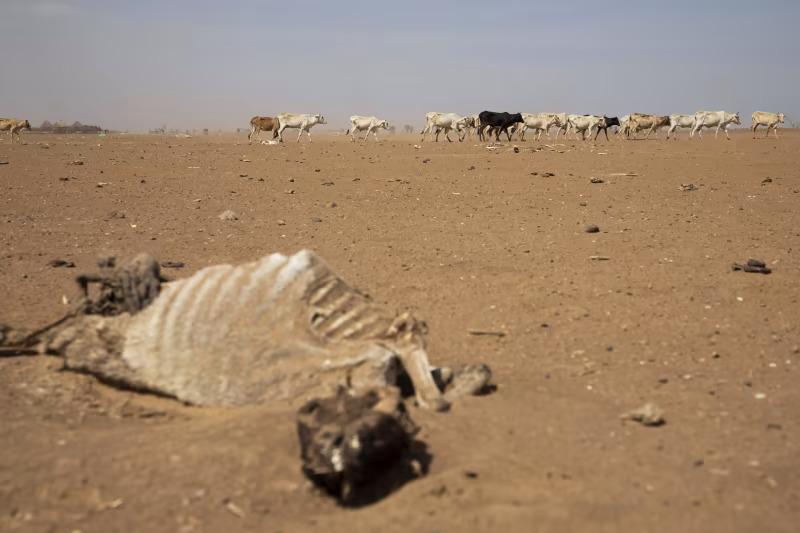AICCRA Ethiopia launches agricultural drought monitoring and warning platform
This post originally appeared on the AICCRA / CGIAR blog.
In the presence of key stakeholders from federal, regional, public, and private sector institutions, Ethiopia launches a milestone NextGen Agricultural Drought Monitoring and Warning System.
“Drought is known to Ethiopians from time immemorial,” declared Minister of Agriculture Oumer Hussien, recalling dramatic images from Ethiopia’s 1972 and 1984 famines.
“And this recurrent drought poses a formidable challenge for the country and its development partners.”
The words, spoken to a room of more than 100 researchers, academics, policymakers, development practitioners, and officials from across the public and private sectors, marked the opening of Ethiopia’s official launch event for its new NextGen Agricultural Drought Monitoring and Warning System (NADMWS) on 20 January 2022.
And the images, recalled from decades in the past, were too eerily familiar as the faces of Ethiopia’s current 5.7 million people affected by severe drought and in need of food assistance have continued to make headlines in the media and through the urgent pleas from humanitarian agencies since early this year.

Part of the problem for mitigating the effects of these persistent and devastating droughts has arisen from an unmet need for timely and accurate climate information about the onset and development of country-wide drought conditions.
And another part has emerged from the reality that even when available, the information is not easily accessible or in a decision-relevant format for those working in the humanitarian space to act on.
The NextGen Agricultural Drought Monitoring and Warning System (NADMWS) takes all of these issues head-on.
Using satellite-based remote sensing technology, combined with detailed land-use maps, seasonal forecasts, national crop statistics, crop phenology and other country-specific data, users can now monitor agricultural areas or “hotspots” with a high likelihood of water stress at the national, regional, zonal and woreda (district) levels.
And critically for decision-makers, the system simulates and automates the analysis that an expert in remote sensing would undertake and simplifies the interpretation and use of the data for users who are not remote sensing experts.
The implications of such a system for transitioning Ethiopia’s disaster risk management sector from reactive and response-oriented to one focusing on proactive early warning, prevention, and preparedness are huge.
And it would not be possible without the robust national data and coordination made possible through the collaborative efforts of AICCRA and partners:
- The Ethiopian Institute of Agricultural Research (EIAR)
- Ethiopian Meteorological Institute (EMI)
- Ethiopian Ministry of Agriculture (MoA)
- International Research Institute for Climate and Society (IRI)
- The Food and the Agriculture Organization of the United Nations (FAO)
- The International Livestock Research Institute (ILRI) under IRI’s Adapting Agriculture to Climate Today, for Tomorrow (ACToday) project.
“Drought monitoring and prediction is critical for making agricultural production resilient to the impacts of drought … And this [NADMWS] system is an important tool that supports the Ministry’s effort to provide digital solutions for agricultural problems.“
H.E. Mr. Oumer Hussien, Ministry of Agriculture for Ethiopia through representative Mr. Wondale Habtamu
So how does it all work? The NADMWS is made possible by and builds off almost a decade of experience from FAO’s implementation of its global Agricultural Stress Index System (ASIS), which went online in 2014.
Based on remote sensing data, this system provides analysts with updated drought indicators on a dekadal basis (every 10 days) at the global level for 196 countries.
However, by complementing global data with national data and fine-tuning the parameters of the system—such as with land-use maps, seasonal forecasts, national crop statistics and other country-specific data—ASIS can be refined for individual countries.
These standalone and tailored country-level versions of ASIS can then better inform and fuel potential applications such as National Early Warning Systems for food security, remote-sensing indices for crop insurance, or other decision-support tools.
The NextGen Agricultural Drought Monitoring and Warning System is the culmination of that effort. It represents a landmark achievement for Ethiopia as the first country ever in Africa to implement country-level ASIS.

However, the launch is just the beginning—Capacity building on the use of NADMWS and other digital innovations from the EIAR, EMI, and both public and private partners will remain pivotal for their ultimate uptake and effectiveness, as will their integration within decision-making processes and frameworks such as the National Framework for Climate Services (NFCS) launched earlier last year.
Both the ACToday and AICCRA projects acknowledge and recognize this imperative of pairing decision-relevant climate information with appropriate capacity building for effective and sustainable climate services solutions and have put training of users at the forefront of their strategies to support national priorities.
For NADMWS, the launch came on the heels of an intensive five-day training on the system with 16 humanitarian actors from both national and international organizations like the National Disaster Risk Management Commission (NDRMC), the United States Agency for International Development (USAID), World Food Programme (WFP), EIAR, and EMI who will use the system. And national partners are doubly committed to doing the same.
“EIAR is adamant about promoting digital agriculture and cascading training to ensure pragmatic solutions on the ground. By working with partners like all those involved in AICCRA, we can ensure that not only are drought research efforts adequately supported but are well integrated within decision-making as we see with this new platform.”
EIAR Deputy Director-General Diriba Gelete, in some of the final remarks of the event that captured its tone.

You must be logged in to post a comment.